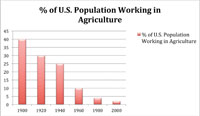
Pushing the Envelope
Story by Laurie Bellah-Strebeck and Photo by USDA
The world population is expected to increase by 50 percent in the next 40 years. This means more mouths to feed, with no new land for crops to feed them. Farmland is being developed every day and water resources are being depleted. There are currently not enough young people going into production agriculture to replace those who are retiring. With all these negative pressures, how will agricultural producers feed the growing world?
In 1940, one American farmer was only producing enough to feed and clothe 19 people, according to the Texas Tech University College of Agricultural Sciences and Natural Resources website. Today, one American farmer alone feeds and clothes approximately 145 people in the United States. If exports are included into these statistics, each American farmer actually feeds and clothes 200 people. How have such extreme leaps been made in production agriculture thus far?
Eduardo Segarra, Ph.D., is the department chair for the Department of Agricultural and Applied Economics at Texas Tech. To the questions how to feed the growing world and how such extreme leaps have been made in agriculture, Segarra said the answer is one in the same.
“There is no doubt that technological progress is the single most important factor in agriculture,” Segarra said.
Segarra explained that technological progress is not something that just happens. It has to be planned, funded and researched, strategized and applied.
Over the next four decades, major steps will have to be made to ensure the world’s population is fed. Research for better plant varieties, production of more efficient equipment and the continuing education of producers are just a few important aspects in increasing agriculture production.
One of the most important and obvious technological changes needed is to increase crop yield. According to the United States Department of Agriculture, 40 years ago the average corn yield was 88.1 bushels per acre. Today, the average corn yield is 152.8 bushels per acre.
Layne Strebeck, senior in agricultural and applied economics, is well aware of the importance of technology in agriculture and is excited to return back to the farm after graduation.
“Obviously, technology is present in agriculture,” Strebeck said. “My granddad farmed with a mule-drawn plow. Now, I’m checking my irrigation sprinklers on my iPhone.”
Strebeck and Segarra agreed that agriculture is the most proactive industry in the world, but producers will have to continuously be willing to adapt to technological changes over time.
“It is very important that we are aware of the fact that we need to keep pushing the envelope,” Segarra said.
Agricultural scientists and researchers are not the only people needed to discover how to feed the growing world. It might be in the form of better educational programs or input from producers. Segarra said that feeding the growing world really involves everyone related to agriculture.
“We know what the population is going to be,” Segarra said, “We know they are going to eat, and we know what we are going to have to produce. We just have to find a way to do it.”